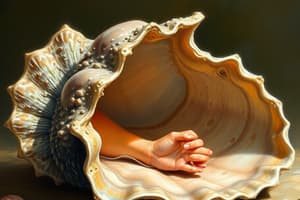Podcast
Questions and Answers
What is the function of the hinge ligament in bivalve shells?
What is the function of the hinge ligament in bivalve shells?
- To filter feed using respiratory currents
- To attach the bivalve to a substrate
- To secrete nacre around foreign material
- To draw the valves together using adductor muscles (correct)
Where is the umbo located in a bivalve shell?
Where is the umbo located in a bivalve shell?
- At the dorsal midline of the shell
- As the oldest part of the shell (correct)
- At the hinge ligament
- Around the foreign material forming pearls
Where are gland cells located that secrete mucus to entangle particles in bivalves?
Where are gland cells located that secrete mucus to entangle particles in bivalves?
- On the foot
- On the labial palps (correct)
- On the ctenidia
- On the mantle
How do scallops and file shells move?
How do scallops and file shells move?
What is responsible for producing pearls in bivalves?
What is responsible for producing pearls in bivalves?
What is the function of the crystalline style in bivalve digestion?
What is the function of the crystalline style in bivalve digestion?
In bivalves, how is food directed into the mouth for ingestion?
In bivalves, how is food directed into the mouth for ingestion?
Where does fertilization usually occur in bivalves?
Where does fertilization usually occur in bivalves?
What is the role of nephridial tubules in bivalve circulation?
What is the role of nephridial tubules in bivalve circulation?
What is the purpose of the three-chambered heart in bivalves?
What is the purpose of the three-chambered heart in bivalves?
How do glochidium larvae complete their development?
How do glochidium larvae complete their development?
Where do juveniles of glochidium larvae usually detach and begin independent life?
Where do juveniles of glochidium larvae usually detach and begin independent life?
Which type of larval stage is hatched with the beginnings of a foot, shell, and mantle in many gastropods and bivalves?
Which type of larval stage is hatched with the beginnings of a foot, shell, and mantle in many gastropods and bivalves?
What class has over 70,000 living and more than 15,000 fossil species, including marine snails, limpets, slugs, whelks, and sea slugs?
What class has over 70,000 living and more than 15,000 fossil species, including marine snails, limpets, slugs, whelks, and sea slugs?
What is the characteristic feature of gastropod shells in terms of coiling formation?
What is the characteristic feature of gastropod shells in terms of coiling formation?
Which type of larvae do cephalopods, some freshwater bivalves, and snails lack?
Which type of larvae do cephalopods, some freshwater bivalves, and snails lack?
What is the smallest and oldest part of the whorl in a gastropod shell?
What is the smallest and oldest part of the whorl in a gastropod shell?
What is the function of the operculum in many snails in relation to the shell?
What is the function of the operculum in many snails in relation to the shell?
Flashcards are hidden until you start studying
Study Notes
Bivalve Anatomy and Functions
- The hinge ligament connects the two halves of a bivalve shell, allowing it to open and close efficiently.
- The umbo is the rounded, elevated area on the shell's dorsal side, often the oldest part of the shell.
- Gland cells that secrete mucus are located in the mantle, allowing for the entrapment of particles for feeding.
Movement and Feeding
- Scallops and file shells can swim by rapidly opening and closing their shells to expel water.
- Pearls are produced by the secretion of nacre by the mantle tissue in response to irritants.
- The crystalline style aids in digestion by rotating within the stomach, mixing food with digestive enzymes.
Reproductive and Developmental Processes
- In bivalves, food is directed into the mouth through ciliary action and water currents created by gills.
- Fertilization typically occurs in the water column or within the gills of the female bivalve.
- Nephridial tubules filter waste from the blood, playing a crucial role in the circulatory system.
Heart and Lifecycle
- The three-chambered heart pumps blood, facilitating circulation and nutrient distribution throughout the body.
- Glochidium larvae undergo a parasitic stage, often attaching to fish gills to complete their development.
- Juveniles of glochidium larvae detach from the host fish and begin independent life in the aquatic environment.
Gastropod and Cephalopod Characteristics
- The larval stage that hatches with initial structures like a foot, shell, and mantle is known as a veliger.
- Gastropoda class includes over 70,000 living species and around 15,000 fossil species, encompassing a variety of marine organisms.
- Gastropod shells display a unique coiling pattern, often resulting in asymmetrical shapes.
- Cephalopods, some freshwater bivalves, and certain snails do not possess a trochophore larval stage.
Shell Structure and Functions
- The protoconch is the smallest and oldest part of the whorl in a gastropod shell, providing the initial shape.
- The operculum functions as a protective cover for many snails, sealing the shell's opening when the animal retreats inside.
Studying That Suits You
Use AI to generate personalized quizzes and flashcards to suit your learning preferences.




